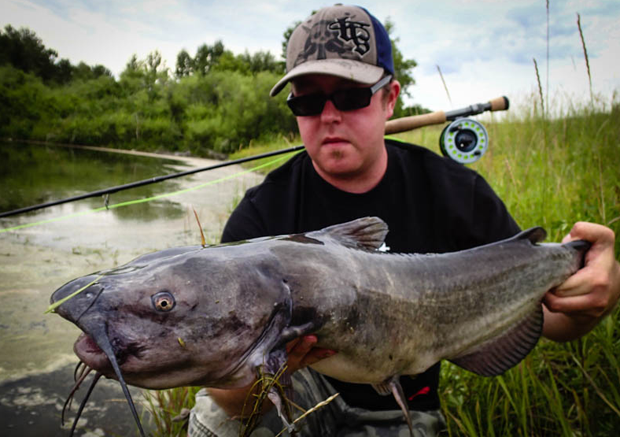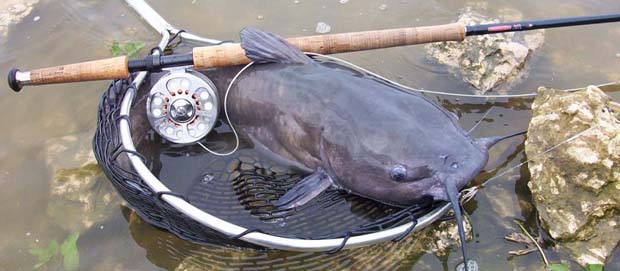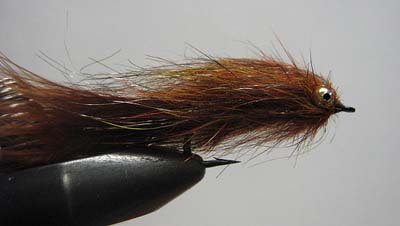A fish hatchery and a fish monger can get you going
[dropcap]A[/dropcap]lmost directly across from the Richmond Hill, Gerogia Fish Hatchery on State Rte 144, just west of 17/25 and 20 miles due South of Savannah, Georgia there’s a stand-alone blue colored shack called Ken’s Seafood Market. There, aside from stepping into the past, you can get locally caught seafood, crustaceans, clams and oysters, as well as fresh water aquatic offerings. All courtesy of the states of Georgia and South Carolina’s commercial fishermen and women.
Channel Cat (Ictalurus, punctatus)
As a regular patron, Ken and I began chatting-up our shared passion, fishing. Our mutual fish catching stories contained the usual exaggerations of “this big.” More, I learned Georgia places to fish for species I never considered targeting (hybrid stripers, catfish, carp and read-ear sunfish), More importantly, how-to fish for them along with exactly where, including seasons, water columns and food preferences. My tying got busy.
Ken, a dedicated catch to eat fan was literally aghast, or should I say stupefied, at my practice of mainly catch and release. The whole idea was completely lost on him. As you might be thinking, he’d pay no attention to season or catch limits. Not so. He’s a fierce rules defender, but says sometimes the state or fed folks just get it all wrong. Who could argue with that?
The famous and historic Altamaha River at Darien
I took Ken’s detailed advice and did an afternoon dry run to the historic town Darien, Georgia on the Altamaha River. It was slightly less than an hour away. I needed to be sure of my bearings, ramp condition and what tidal flow looked like and take a water temperature before assaulting the river in the dark.
The water temperature was seasonably 61-degrees. Not optimum for cats but they’ll feed at that temperature. I surveyed the river all afternoon – mixing in visits to historical edifices, placards, sites and a local restaurant for lunch.
At 4 am a few days later, I drove to my friend Tom Washington’s house. Tom, a retired military sarge fresh-out and recent transport from Texas, is an avid angler from the spin and bait cast tribe. We rumbled down the road towing his aluminum skiff with a 50HP Yamaha. It was an unusually chilly and windy 45 degree March morning. The weather lady promised it would warm to a windless and sunny 70 degree day by noon.
We made the ramp on the Altamaha River ramp in Darien around 5 am and were launched and anchored 100 or so yards East of the I-95 bridge in about 45 minutes. We were fishing an outgoing tide. The day’s new light was barely visible in the east – just peeping at us on the horizon.
The river
The Altamaha River empties about 100,000 gallons of fresh water a minute into the Atlantic Ocean so salinity stays low in part-per-million. Channel cats can tolerate up to about 19/20 PPM.
At certain rain events, coupled with up river releases from the dam, freshwater can be found all the way to the Atlantic ocean.
Lights, camera, action
Tom was hit on his second spin cast. A channel cat of about 4-pounds. He’d produce six more cats before I landed a nice 8-pounder that slurped a self-tied #2 black muddler that hung from an 8-weight with an intermediate-sink and a fast sinking RIO Versatip on a trailing knotless 9-foot RIO – 16 pound test tippet. The weighted fly (wire) allowed me to produce an up down retrieve.
The pull when hit was an unexpected reward. Mr. Cat wanted to go deep and into the marsh grass, a snook trick mimicked. The ferocity and stamina of a cat has made me an instant convert. This was no junk fish that snobs claim it to be.
You can most certainly catch catfish on a fly
The day ended with 15 kept cats – all but four caught by Ken and all on a varied artificials. No bait was used. My first fish, the 8-pounder, was the biggest.
The other rewards were redfish tailers in the 3- to 4-pound class. They all fell for my Pine Island Ice Tea. I was using a 9-weight with floating line with a 10-foot, 16-pound leader. We found them in a marshy creek potholes – seaward of Darien. We were fishing the mid stage of an incoming tide.
On fading light, a sure double digit tailing red spit Tom’s artificial after a few tugs and short burst run. It was the last cast of the day.
We cleaned the cats and parted Darien, exhausted, just after sundown.
Catching cats on a fly
Cats are not dedicated look-down bottom feeders as some will claim. They’ll feed on anything that will fit into their mouth, bottom carrion to hatching bugs and anything in-between. Actually, they’re a fly tyers best friend because they’re not picky and your messy looking Muddler Minnow, Lefty’s Deceiver, Clouser’s Minnow or Woolly Bugger will do just fine. If you’re in a permanent freshwater environment you’ll find your trout flies will work fine, even dries when there’s a hatch happening.
A favorite cat-fly of mine has become a DDH leech pattern tied by Stu Thompson, which gets tied on different hook sizes and color combinations, but always with the same eyes. In addition, the pattern has thus-far proven to have an across the board appeal: largemouth bass, bream-crappie, hybrid stripers and reds.
For the best catfish reward, pay a guide to take you out. You’ll learn more from him or her in one day than in two dozen on you own.
[information]
[/information]





